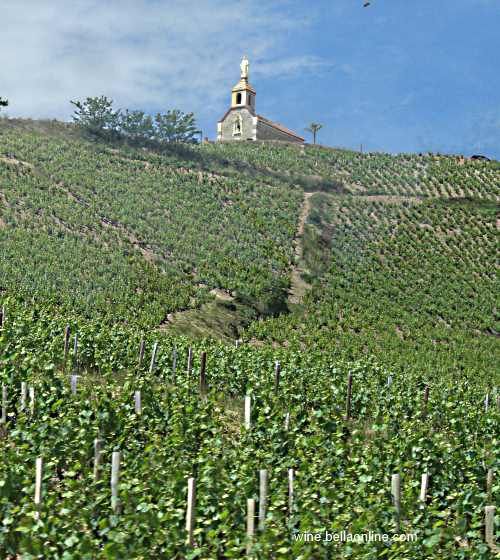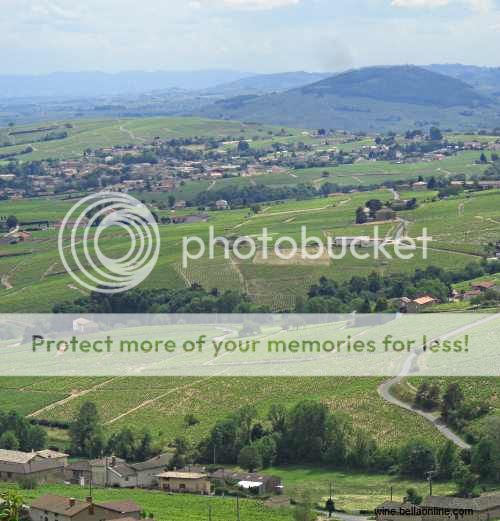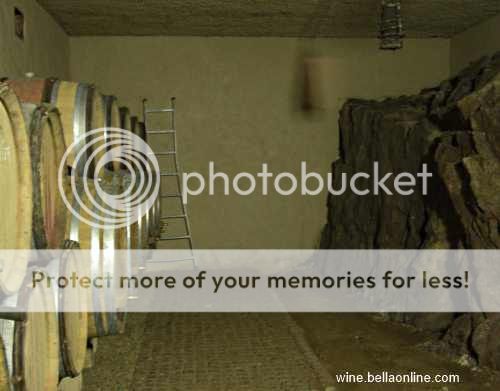Domaine de la Madone, Fleurie, Beaujolais

Visiting wine lands gives me an understanding that no map or book can. Travelling through Beaujolais I was surprised at just how compact and densely planted the region is. Leaving Chateau de Pizay in the Morgon appellation and passing through the small town of Morgon the road-side sign with the name ‘Morgon’ crossed with a red diagonal line indicated we had left the town. A few metres on was the sign ‘Fleurie’ to show we were entering that village. Although Fleurie and Morgon rub up against each other, the wines from these two appellations are distinctively different.
Fleurie, as suits its name, is rather flowery in its scent and delicate in taste and is often referred to as a feminine wine. Wines from neighbouring Morgon, on the other hand, are meaty mouth-filling and masculine. And both made from the same variety – Gamay.

Fleurie village is overlooked by a steep hill. On its crown is a chapel (pictured above)with a large statue of the Madonna standing on the top of its tower. The statue can be seen for miles, and when you reach the chapel, from there you can see in all directions over the Beaujolais region. I looked back over Fleurie to Morgon and then behind was a solid conical hill of Brouilly.

This remnant of an ancient volcano (pictured above right with upper slopes covered in dark trees) gives wines grown on and around it their particular flavour. I’d heard about this feature at tastings and read of it, but the reality will live on in my memory as no description could.
Just below the chapel is Domaine de la Madone, a fifth generation family owned winery whose vineyards grow on the hill’s pink granite soils. Jean-Marc Despres and his son Arnaud tend vines and make wine while Jean-Marc’s wife Maryse runs the winery restaurant and guesthouse. We ate on the restaurant terrace looking across to Brouilly. Immediately below the restaurant is the Despres’s oldest vineyard, planted by Jean-Marc’s grandfather in 1889 after phylloxera had wiped out the previous vineyard.

Arnaud (pictured above) bucked convention by planting some Viognier in 2009. This not a traditional Beaujolais variety and so cannot be labelled as Fleurie or Beaujolais, but Arnaud says his granite soils are just perfect for Viognier and tasting the 2012, the very first vintage from those young vines shows he has a point. It had all the expected classic rounded apricot flavours with a refreshing minerality. Domaine de la Madone produce a range of Fleurie wines with different wood aging and a single vineyard bottling titled 1889 from the oldest vineyard. It was a pleasure to drink this at the winery just metres from the very vineyard that produced it.

pictured above - Domaine de la Madone's cellars are hewn from the granite hillside
Talk about wine on our forum.
Peter F May is the author of Marilyn Merlot and the Naked Grape: Odd Wines from Around the World which features more than 100 wine labels and the stories behind them, and PINOTAGE: Behind the Legends of South Africa’s Own Wine which tells the story behind the Pinotage wine and grape.
which features more than 100 wine labels and the stories behind them, and PINOTAGE: Behind the Legends of South Africa’s Own Wine which tells the story behind the Pinotage wine and grape.
Disclosure - Peter F May paid in full for his visit, tasting, food and all the wines he brought home.
Fleurie, as suits its name, is rather flowery in its scent and delicate in taste and is often referred to as a feminine wine. Wines from neighbouring Morgon, on the other hand, are meaty mouth-filling and masculine. And both made from the same variety – Gamay.

Fleurie village is overlooked by a steep hill. On its crown is a chapel (pictured above)with a large statue of the Madonna standing on the top of its tower. The statue can be seen for miles, and when you reach the chapel, from there you can see in all directions over the Beaujolais region. I looked back over Fleurie to Morgon and then behind was a solid conical hill of Brouilly.

This remnant of an ancient volcano (pictured above right with upper slopes covered in dark trees) gives wines grown on and around it their particular flavour. I’d heard about this feature at tastings and read of it, but the reality will live on in my memory as no description could.
Just below the chapel is Domaine de la Madone, a fifth generation family owned winery whose vineyards grow on the hill’s pink granite soils. Jean-Marc Despres and his son Arnaud tend vines and make wine while Jean-Marc’s wife Maryse runs the winery restaurant and guesthouse. We ate on the restaurant terrace looking across to Brouilly. Immediately below the restaurant is the Despres’s oldest vineyard, planted by Jean-Marc’s grandfather in 1889 after phylloxera had wiped out the previous vineyard.

Arnaud (pictured above) bucked convention by planting some Viognier in 2009. This not a traditional Beaujolais variety and so cannot be labelled as Fleurie or Beaujolais, but Arnaud says his granite soils are just perfect for Viognier and tasting the 2012, the very first vintage from those young vines shows he has a point. It had all the expected classic rounded apricot flavours with a refreshing minerality. Domaine de la Madone produce a range of Fleurie wines with different wood aging and a single vineyard bottling titled 1889 from the oldest vineyard. It was a pleasure to drink this at the winery just metres from the very vineyard that produced it.

pictured above - Domaine de la Madone's cellars are hewn from the granite hillside
Talk about wine on our forum.
Peter F May is the author of Marilyn Merlot and the Naked Grape: Odd Wines from Around the World
Disclosure - Peter F May paid in full for his visit, tasting, food and all the wines he brought home.
You Should Also Read:
Chablis - Chardonnay Personified

Related Articles
Editor's Picks Articles
Top Ten Articles
Previous Features
Site Map
Content copyright © 2023 by Peter F May. All rights reserved.
This content was written by Peter F May. If you wish to use this content in any manner, you need written permission. Contact Peter F May for details.


